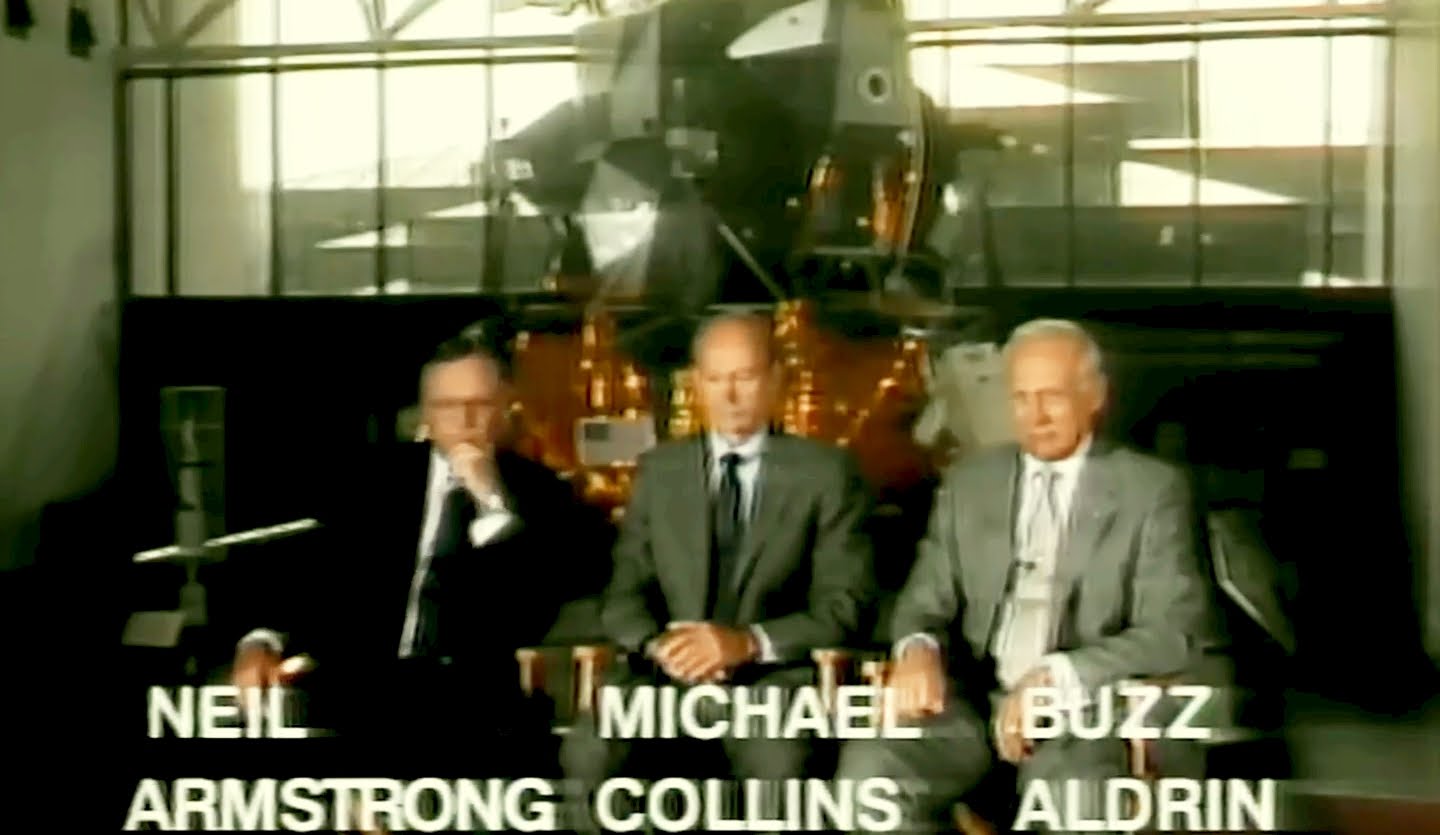more at
The first men on the moon, Apollo 11 Commander Neil Armstrong and Lunar Module pilot Edwin E. “Buzz” Aldrin, and Command Module Pilot Michael Collins, are interviewed at the Smithsonian Institution National Air and Space Museum on May 26, 1989.
Public domain film from NASA, slightly cropped to remove uneven edges, with the aspect ratio corrected, and mild video noise reduction applied.
The soundtrack was also processed with volume normalization, noise reduction, clipping reduction, and/or equalization (the resulting sound, though not perfect, is far less noisy than the original).
Apollo 11 was the spaceflight that landed the first humans on the Moon, Americans Neil Armstrong and Buzz Aldrin, on July 20, 1969, at 20:18 UTC. Armstrong became the first to step onto the lunar surface six hours later on July 21 at 02:56 UTC. Armstrong spent about two and a half hours outside the spacecraft, Aldrin slightly less, and together they collected 47.5 pounds (21.5 kg) of lunar material for return to Earth. The third member of the mission, Michael Collins, piloted the command spacecraft alone in lunar orbit until Armstrong and Aldrin returned to it just under a day later for the trip back to Earth.
Launched by a Saturn V rocket from Kennedy Space Center in Merritt Island, Florida, on July 16, Apollo 11 was the fifth manned mission of NASA’s Apollo program. The Apollo spacecraft had three parts: a Command Module (CM) with a cabin for the three astronauts, and the only part that landed back on Earth; a Service Module (SM), which supported the Command Module with propulsion, electrical power, oxygen, and water; and a Lunar Module (LM) for landing on the Moon (which itself was composed of two parts). After being sent toward the Moon by the Saturn V’s upper stage, the astronauts separated the spacecraft from it and traveled for three days until they entered into lunar orbit. Armstrong and Aldrin then moved into the Lunar Module and landed in the Sea of Tranquility. They stayed a total of about 21 1⁄2 hours on the lunar surface. After lifting off in the upper part of the Lunar Module and rejoining Collins in the Command Module, they returned to Earth and landed in the Pacific Ocean on July 24.
Broadcast on live TV to a world-wide audience, Armstrong stepped onto the lunar surface and described the event as “one small step for [a] man, one giant leap for mankind.” Apollo 11 effectively ended the Space Race and fulfilled a national goal proposed in 1961 by the U.S. President John F. Kennedy in a speech before the U.S. Congress: “before this decade is out, of landing a man on the Moon and returning him safely to the Earth.”
Throughout the descent Aldrin had called out navigation data to Armstrong, who was busy piloting the LM. A few moments before the landing, a light informed Aldrin that at least one of the 67-inch (170 cm) probes hanging from Eagle’s footpads had touched the surface, and he said “Contact light!” Three seconds later, Eagle landed and Armstrong said “Shutdown.” Aldrin immediately said “Okay, engine stop. ACA – out of detent.” Armstrong acknowledged “Out of detent. Auto” and Aldrin continued “Mode control – both auto. Descent engine command override off. Engine arm – off. 413 is in.”
Charles Duke, CAPCOM during the landing phase, acknowledged their landing by saying “We copy you down, Eagle.”
Armstrong acknowledged Aldrin’s completion of the post landing checklist with “Engine arm is off”, before responding to Duke with the words, “Houston, Tranquility Base here. The Eagle has landed.” Armstrong’s unrehearsed change of call sign from “Eagle” to “Tranquility Base” emphasized to listeners that landing was complete and successful. Duke mispronounced his reply as he expressed the relief at Mission Control: “Roger, Twan— Tranquility, we copy you on the ground. You got a bunch of guys about to turn blue. We’re breathing again. Thanks a lot…”
At 02:39 UTC on Monday July 21, 1969, Armstrong opened the hatch, and at 02:51 UTC began his descent to the lunar surface. The Remote Control Unit controls on his chest kept him from seeing his feet. Climbing down the nine-rung ladder, Armstrong pulled a D-ring to deploy the Modular Equipment Stowage Assembly (MESA) folded against Eagle’s side and activate the TV camera, and at 02:56:15 UTC he set his left foot on the surface. The first landing used slow-scan television incompatible with commercial TV, so it was displayed on a special monitor and a conventional TV camera viewed this monitor, significantly reducing the quality of the picture…
After describing the surface dust as “very fine-grained” and “almost like a powder,” Six and a half hours after landing, Armstrong stepped off Eagle’s footpad and declared, “That’s one small step for [a] man, one giant leap for mankind…”

